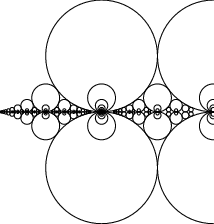|
|
|

Pick any two Integers ![]() and
and ![]() , then the Circle of Radius
, then the Circle of Radius ![]() centered at
centered at
![]() is known as a Ford circle. No matter what and how many
is known as a Ford circle. No matter what and how many ![]() s and
s and ![]() s are picked, none of the Ford circles intersect
(and all are tangent to the x-Axis). This can be seen by examining the squared distance between the
centers of the circles with
s are picked, none of the Ford circles intersect
(and all are tangent to the x-Axis). This can be seen by examining the squared distance between the
centers of the circles with ![]() and
and ![]() ,
,
| (1) |
| (2) |
| (3) |
See also Adjacent Fraction, Farey Sequence, Stern-Brocot Tree
References
Conway, J. H. and Guy, R. K. ``Farey Fractions and Ford Circles.'' The Book of Numbers. New York:
Springer-Verlag, pp. 152-154, 1996.
Ford, L. R. ``Fractions.'' Amer. Math. Monthly 45, 586-601, 1938.
Pickover, C. A. ``Fractal Milkshakes and Infinite Archery.'' Ch. 14 in Keys to Infinity. New York:
W. H. Freeman, pp. 117-125, 1995.
Rademacher, H. Higher Mathematics from an Elementary Point of View. Boston, MA: Birkhäuser, 1983.